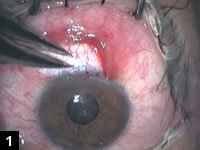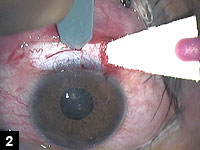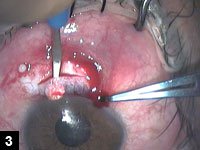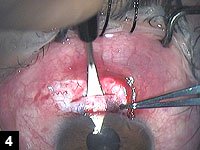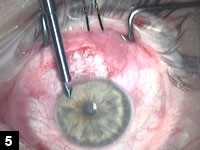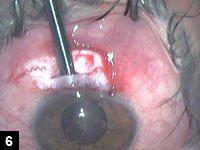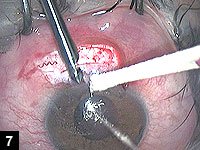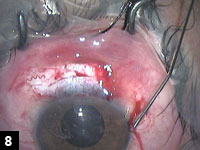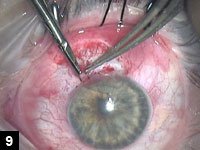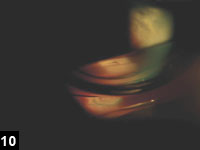Primary trabeculectomy without iridectomy easier with Jacobs membrane punch
Surgeons outline technique using the Jacobs membrane punch, which allows easier tunnel insertion.
The introduction of the Jacobs membrane punch has improved the technique of primary trabeculectomy without iridectomy.
We began developing the technique using a membrane punch in 1997 and presented results in November 1998 at the United Kingdom and Ireland Glaucoma Society meeting.
Twenty-eight primary trabeculectomies in 18 patients were followed for a mean of 7.6 months and compared to a group of standard trabeculectomies. At that stage, a Crozafon-De Laage punch, a high-viscosity viscoelastic and 5-FU were used. Postop, mean IOP and the number of medications used per eye dropped. Complications compared favorably to the standard group with one iris incarceration and no flat anterior chambers.
Since then, the method and instrumentation have been changed with the introduction of the Jacobs membrane punch from Duckworth & Kent.
Surgical method
We begin by placing a superior rectus suture. If a corneal traction suture is preferred, it is better to use two stay sutures at the 10 and 2 o’clock positions, rather than a 12 o’clock suture. A fornix-based flap is then created. If there is a large excess of Tenon’s capsule, some can be dissected. A deep pocket is freed under the conjunctiva and cautery is applied to scleral bleeding points. The corneal surface and free edge of the conjunctiva are protected with viscoelastic. I use mitomycin C for up to 3 minutes or longer in complicated cases, placing it well back in the conjunctival pocket. At removal of the sponge, the surgeon should irrigate thoroughly and dry to remove all traces of antimetabolite.
Calipers are used to measure 1.5 mm behind the surgical limbus/blue-white junction, then I cut a groove approximately 4-mm long with a BD 300-µm guarded disposable blade. I use a double-bevel 2.2-mm angled spoon blade, and keep the blade flat in the same plane to 1 mm anterior to the surgical limbus.
The surgeon should check again that the scleral surface is dry before entering the anterior chamber. I use a phaco slit knife around 3 mm in width to enter the anterior chamber at an angle of approximately 45°. I fill the anterior chamber with the chondroitin sulfate component of DuoVisc (chondroitin sulfate, sodium hyaluronate, Alcon) to ensure a deep anterior chamber.
The tip of the membrane punch is then introduced along the tunnel with the hook facing downward and in the open position. When the tip enters the anterior chamber, the surgeon should withdraw slowly to check engagement of the hook. Once engaged, I exert a gentle traction backward and squeeze the grip to close the blade. When the punch maneuver is completed, I keep the grip closed and withdraw gently. On opening the grip, the tissue specimen can be removed from the punch. At this point I check that the anterior chamber is still deep and there is no problem with the iris coming forward.
The function of the drainage can be tested by pressure on the side of the limbus. A slow ooze of viscoelastic indicates success. It is possible to do a second incision at 90° to the trabeculectomy and fill with viscoelastic or otherwise top up through the trabeculectomy site. I then clean the sclera and check for viscoelastic ooze once again. If flow is poor even after passing the cannula through the tunnel, then it is possible to partly cut one side of the flap or even partly cut both sides to result in good flow. However, this is rarely required.
Scleral sutures are not needed unless converting to a standard trabeculectomy with iridectomy. Some viscoelastic can be introduced into the conjunctival pocket. I close with interrupted 10-0 Vicryl suture, assuring safe closure with the conjunctiva well onto the cornea and secured at either side of the scleral tunnel but with no central suture over the tunnel.
Subconjunctival injections of 5-FU can be used postoperatively if desired. My postoperative management includes steroid and antibiotic drops. We no longer use miotics as these shallow the anterior chamber in some patients.
|
|
|
|
|
|
|
|
|
|
|
|
|
|
Images: Jacobs NA |
Special precautions
Eyes with a moderately deep peripheral anterior chamber, including plateau iris cases, are suitable. Eyes with a floppy or damaged iris are excluded.
The eye must be soft after local anesthesia. Otherwise, the iris will come forward during the punch part of the procedure and increase the risk of complications.
It is imperative to flush away and fully dry all traces of mitomycin C before entering the anterior chamber because of the toxicity of even trace amounts.
The surgical limbus is used as a reference, and the conjunctival insertion point is ignored.
The Stylus 2.2-mm angled spoon blade is double-beveled and not so sharp as to alter the chosen plane of dissection. Some other manufacturers make the same blade. If the anterior chamber is entered too posteriorly, I convert to trabeculectomy with peripheral iridectomy.
The chondroitin sulfate component of DuoVisc is used to deepen the anterior chamber. It is left in the anterior chamber postoperatively. A viscoelastic such as Healon GV, (sodium hyaluronate, Advanced Medical Optics) cannot be left in the anterior chamber postoperatively without risk of high IOP. Normal viscosity viscoelastic cannot maintain a deep enough anterior chamber during the procedure.
If the iris is damaged or comes forward during the procedure, I convert to a scleral flap by one or two cuts and a peripheral iridectomy.
Care is needed when removing excised material to avoid touching the blade of the Jacobs membrane punch with a metal instrument. The protective sleeve is kept on the instrument for storage and sterilization.
In combined phaco-trabeculectomy, protection of the cornea with viscoelastic during mitomycin C application is vital to maintain a clear view during surgery. The best stage to use the membrane punch is after phacoemulsification, having filled the anterior chamber with viscoelastic. If the axial length is very short, as it is in high hypermetropia, even after lens extraction, a peripheral iridectomy is advised.
Discussion
The use of punches adapted for a scleral tunnel approach began with the Crozafon de Laage punch. Unlike the Kelly punch or its later alternatives, an open-sky view is not required. Crozafon suggested that a peripheral iridectomy is optional. Others have used this punch with or without a peripheral iridectomy, or with either method. In suitable eyes, omission of a peripheral iridectomy may confer some advantages as normal intraocular circulation of aqueous through the pupil is maintained, and there could be a lower incidence of cataract formation after trabeculectomy. Also, there is less surgical trauma. Technically, it would seem more difficult to perform a peripheral iridectomy down a true scleral tunnel, and if a peripheral iridectomy is used, an open-sky punch makes more sense.
These techniques tend to enter the anterior chamber more anteriorly, thus the membrane removed is corneal rather than trabecular tissue. With this in mind, we prefer to start our sutureless tunnel 1.5 mm behind the surgical limbus; relying on conjunctival insertion can be misleading because of anatomical variation. We would agree with Ahmed that flat anterior chambers are hardly ever seen with this approach to anterior chamber entry.
For Your Information:
- N.A. Jacobs, FRCS, FRCOphth, can be reached at 137 Coombe Lane W., Kingston, England, KT2 7HF; +44-020-3942-2960; fax: +44-020-8336-0779. Dr. Jacobs has no direct financial interest in the products mentioned in this article, nor is he a paid consultant for any companies mentioned.
References:
- Crestani A, De Natale R, et al. Phacotrabeculectomy with or without punch: preliminary results comparing the two techniques. Ophthalmologica. 1997;211:72-74.
- Ferentini F, Caccavale A. Scleral tunnel sutureless primary trabeculectomy. Ocular Surgery News Europe/Asia-Pacific Edition. March 1997: 1, 28.

